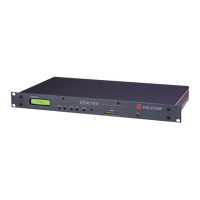TROUBLESHOOTING
VORTEX EF2211/EF2210 Reference Manual 38 Technical Support: 800.932.2774
tion of the EF2211/EF2210. If you hear residual echo, one of the following
conditions may be causing the problem.
Reverberation vs.
Acoustic Echo
Do not confuse the residual echo of remote speech with the reverberation of local
speech. Reverberation of local speech is caused when the speech signal arrives at the
microphone via several paths (the direct path and multiple reflections from surfaces in
the room). This is a local room phenomenon that gives the talker’s voice a hollow or
resonant sound (as heard at the remote end).
Reverberation is not an artifact of the echo canceller. It is mainly affected by the dis-
tance of the microphone from the speech source and by the resonances of the room.
While reverberation can be unpleasant, it is not compensated for by the acoustic echo
canceller (AEC), which only removes reflections of remote speech. If the remote end
complains that they hear echo, ensure that they are referring to hearing their own
voice and not echoes of local talkers.
You cannot remove the effects of reverberation by changing the EF2211/EF2210’s
settings, but you can minimize reverberation by moving microphones closer to talkers
and, if necessary, adding acoustical treatment to the room.
Finding the
Source of Echo
Try muting one channel at a time to see if the echo that the remote end is hearing goes
away when a particular channel is muted. If you find that the echo goes away when a
particular channel is muted, the microphone may not be calibrated correctly. Check
one or more of the following issues.
Room Gain The most common cause of poor echo cancellation performance is incorrectly
adjusted room gain. This may be explained as follows. The reference signal seen by
the AEC is sent to a loudspeaker output, where it is amplified and sent to the room
Figure 25. Reverberation vs. Acoustic Echo.
AEC
Reverberation
Acoustic Echo

